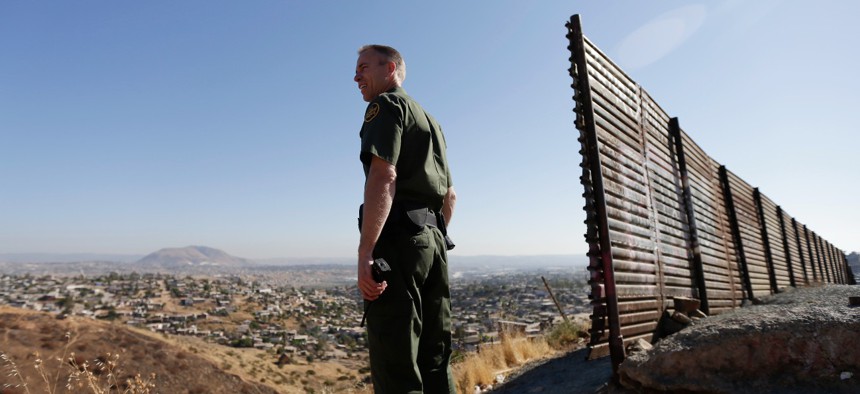
AP file photo
DHS Begins Deploying Body Cameras for Some Border-Based Law Enforcement Personnel
CBP will issue cameras to only a fraction of CBP personnel, who will maintain discretion in activating them.
The Homeland Security Department will begin equipping some of its law enforcement personnel with body cameras this year, calling the move a “first step” that will boost transparency and accountability at the agency.
Customs and Border Protection will deliver the initial tranche of cameras to Border Patrol agents in both the southwest and along the northern border, and eventually to officers with the Office of Field Operations. CBP plans to equip 6,000 officers and agents with cameras by the end of the year.
“Our agents and officers serve the public and protect our borders every day with great skill and professionalism,” said CBP acting Commissioner Troy Miller. “Providing them with state-of-the-art technology and tools like body-worn cameras will support their work and provide greater transparency into interactions between CBP officers and agents and the public.”
The move to provide the cameras to CBP personnel comes after a lengthy process that began with a feasibility study in 2014. Congress has pushed the agency to deploy the cameras and eventually provided funding for it, but CBP conducted additional testing and research in 2017 and 2018. It signed a $13 million contract with a vendor for the cameras last year.
CBP personnel will maintain some discretion in using the cameras. While the cameras will always be on in the background, employees will have to activate them to save footage starting two minutes before that activation. The agency said it has set up “protocols for agents and officers to follow when activating their cameras” that focus on the “safety of personnel and the public.”
It added the cameras will enable better investigation of potential misconduct. Border Patrol agents came under fire during the Obama administration after facing allegations of excessive use of force and many advocacy groups have since called for cameras. CBP said it would retain footage “based upon the nature of the incident and its evidentiary value.”
Brandon Judd, president of the National Border Patrol Council, said his union has long supported the cameras as they would assist in both criminal investigations, provide exculpatory evidence for his members and create useful footage for training. NBPC negotiated with CBP management over the implementation of the program, which Judd said will demonstrate “the vast majority” of agents conduct themselves properly.
“If there are agents out there that are doing things wrong, the good officers and agents don’t want to work with them,” Judd said.
Rep. Adriano Espaillat, D-N.Y. has led the charge to bring body cameras to CBP law enforcement personnel, but said the discretion of when to turn them on the agency left to its officers is "not exactly what I had in mind." Espaillat said he will monitor the program to see if additional legislative action is necessary, but he praised CBP for getting the ball rolling.
"It will guard civilian rights and protect officers against any wrongful allegations against them," Espaillat said. "There are some kinks in it, but nevertheless there is a start."
CBP is the largest law enforcement agency in the country and it offered no timeline for when it plans to expand the camera program beyond the initial 6,000. Border Patrol has nearly 20,000 agents and CBP’s OFO has nearly 30,000 officers. A spokesman said a larger rollout would be dependent on funding and noted not all agents—such as those working desk jobs in Washington—will eventually be slated to receive cameras.
The Biden administration has pushed for more accountability measures for CBP staff. In his fiscal 2022 budget, the president called for a combined $84 million boost to the Offices of Professional Responsibility at both Customs and Border Protection and Immigration and Customs Enforcement to more expeditiously address complaints against their workforces. Under an immigration reform package the White House released earlier this year, new CBP hires would receive onboarding training regarding accountability, standards for professional and ethical conduct, and oversight. The training would focus on community policing, cultural awareness and strategies for interacting with vulnerable populations. All employees would have a “continuing education” requirement for training on individuals’ civil and constitutional rights as well as the department’s use-of-force policies.
A recent Justice Department report found about 80% of non-federal law enforcement had instituted body camera policies. In June, Deputy Attorney General Lisa Monaco issued a new policy requiring the cameras for the department’s law enforcement officers engaged in executing search warrants and making pre-planned arrests. Until 2019, Justice banned even local law enforcement working with its federal officers from wearing body cameras during joint operations. It has since launched a pilot program with a few cities to allow the local officers to wear cameras when their departments’ policies require them. A recent inspector general report found the department’s inexperience with the cameras has left it ill prepared for the initiative and vulnerable to significant implementation difficulties.
House Democrats have pushed police reform bills in each of the last two years that called for all federal law enforcement personnel to wear body cameras. They separately passed a measure earlier this year to require them for the Veterans Affairs Department’s police officers.







